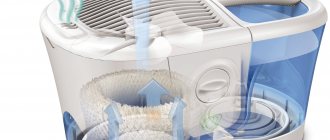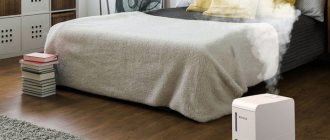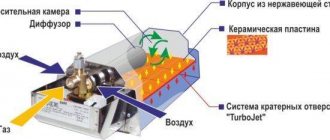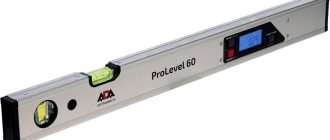- Types of split systems
- Varieties
- Characteristics
- What types of split systems are there?
- Split system for an apartment
- Split system for office
What types of split systems are there? The answer is quite simple: those that hang on the wall, cassette and channel, column; which stand on the floor, multi, inverter. This equipment is installed separately for each type of room; for houses, wall-hung equipment is used; where there is a large distance from floor to ceiling, cassette equipment is used. Ducted options are installed in places where there is a suspended ceiling, freshness is distributed throughout the area using air ducts, and ducted ones supply clean, cooled air into the room. Systems with strong power allow you to save money, while cooling a large amount of area, using a minimum amount of energy.
The floor view often works in office spaces, where many people gather; the wall view is simply not possible. The purpose of each split system is to create an area near itself where there will be more free air; there will be no work in that area. One square meter will be enough; with this type of work, fresh air will rise high, and employees will not be able to catch a cold.
Columned ones are used in spaces where there is a lot of space; it is prohibited to install the block on walls and ceilings; installation in theaters and museums is prohibited. The system produces a lot of cold air, it is usually used in places such as corridors and cafes.
What is a split system, where is it used and what does it consist of?
Generally speaking, a split system is one of the types of air conditioners that is most convenient to use and is in greatest demand.
The device is especially relevant in houses where central air conditioning is not provided.
The advantages of a split system include efficiency and low noise levels (especially in comparison with monoblocks). Such advantages were achieved by dividing the equipment into two blocks - internal and external.
The external part is equipped with a condenser, compressor and fan. The block is installed on the external part of the structure (on the roof, on the wall or balcony). The noise level of this unit is about 50-60 dB.
The second part (indoor unit) contains a fan and an evaporator, and the installation is carried out inside a refrigerated room. Here the noise level is lower - 25-30 dB.
Thanks to this feature, the sound from the air conditioner was reduced by almost a thousand times. So it is not surprising that such systems have become widespread in all residential premises - in apartments, houses, offices and other buildings.
Varieties
A split system is an air conditioner that consists of several units: external and internal. It works almost silently. Types of split systems: duct and industrial.
Duct air conditioners are equipment for closed work. There is a spinner inside. The selection goes separately for individual ventilation; only an experienced specialist can select it. If you do something wrong, the cooling performance may be affected. The main thing in work is not strength, but the ability to circulate oxygen throughout the entire network. If the equipment works efficiently, there will be no extraneous sounds that may appear at its maximum load. The split system is used where the space is more than 300 square meters. m. Split is installed in warehouses and commercial premises. The equipment can be cooled at low cost.
Industrial duct-type systems serve large areas in size; the manure system must be installed in the ventilation. In offices, the cassette version is usually used. The indoor unit is placed next to the suspended ceiling, the space should be more than 250 mm. Column type systems have cooling options for large spaces, suitable for boardrooms and large spaces. The main disadvantage of such structures is the very small distance between the blocks.
Types of split systems
What determines their choice, pros and cons, which of them are most common and popular. As noted above, the device consists of two separate blocks - internal and external.
Both elements are connected to each other using copper tubes and electrical cables. The main differences concern the device mounted indoors.
Here are the following options for split systems:
- Wall-mounted.
- Floor-standing.
- Ceiling-mounted.
- Duct.
- Cassette.
- Floor-ceiling.
Before choosing a split system, it is worth understanding the features of its placement. Each type of device is designed for a specific room. For example, wall-mounted split systems are more suitable for apartments and private houses. This type of device is household.
As for other types of products, they fall into the commercial category.
Their peculiarity lies in their ability to serve rooms where there are a large number of people.
Despite their greater efficiency, there is no point in installing commercial air conditioners in ordinary apartments with a small area.
This is due to the fact that it will not be possible to fully use the capabilities of such models, but you will have to overpay for using the split system.
Some experts do not agree with this opinion. They assure that duct and cassette air conditioners, as well as floor and ceiling split systems can be used in a private home.
The main thing is that the selection and installation is carried out by a professional. The peculiarity of duct and cassette split systems is that they require a large ceiling space.
They do an excellent job of air-conditioning rooms with high ceilings or unusual geometric shapes.
In addition, complex systems are more economical compared to classical devices.
Duct air conditioners
Some experts claim that the best solution is ducted air conditioners.
Their advantages:
- Compactness. Such devices take up minimal space and can be installed in a hallway or utility room;
- You can do without installing an indoor unit. Instead, special grilles are installed in the room, which can be easily matched to any interior;
- With one unit you can cool and ventilate several rooms at once;
- Ensures uniform distribution of air in a room of any shape, including irregular ones.
But there is one difficulty. To install and configure such a split system in an apartment or house, you must invite a specialist who will wisely approach the placement of air ducts, the indoor unit, and also quickly resolve any problems that arise.
It is worth highlighting one more significant disadvantage.
A ducted air conditioner guarantees that the average temperature is achieved for all rooms, and individual control becomes unavailable. In addition, due to the presence of channels, odors can be transferred between rooms.
Cassette air conditioner
If the room has a high ceiling, the best solution is a cassette air conditioner.
Its advantages lie in its ability to evenly distribute and renew the air in the room. But here, as in the previous case, you cannot do without a ceiling space - from 20 cm or more.
For channel devices, this figure is from 25 cm. It must be remembered that channel and cassette systems are important not only to choose correctly, but also to install taking into account existing rules.
This is due to the fact that the air and freon pipelines are behind the beautiful finish.
If the system fails, cost savings on installation may require more expensive and time-consuming repairs and restoration. When choosing, it is important to take into account not only the type, but also the power of the split system and its performance.
On average, 10 square meters of space requires 1 kW of power. This requirement is relevant for standard ceiling height (2.5 m). It is also worth considering the glass area, the number of people in the room, the presence of equipment and other heat sources.
That’s why you should turn to professionals in your field for help in choosing and installing. A good option is split systems with an air ionizer. Their peculiarity lies in the additional purification of the air, as well as its saturation with ions, which have a positive effect on well-being.
Such devices are often installed in children's rooms of private houses or apartments. An interesting option are air conditioners made using Mega Ion+Patrol Sensor technology. E
This is a Japanese development, the essence of which is the generation of negative ions with the OH group.
The latter removes harmful bacteria from the air and deactivates existing viruses. In addition, the overall efficiency of such split systems is 40-50 percent higher.
General recommendations for selection
In conclusion, here are some practical tips for specific situations:
- For a room of 25 square meters with standard ceilings, a split system with a power of 2.5-2.6 kW is suitable.
- In a 2-3-room apartment, if you need to provide air cooling for all rooms, you can install a separate wall split in each of them. Such a kit will almost certainly cost less than a multi-split system.
- In an apartment with high ceilings that is just being renovated, you can install a ducted air conditioning system.
- For a 4 or more room apartment, a multi split system is more suitable - you don’t have to hang a large “cluster” of external units on the facade.
- In a spacious country house you can also install a multi-split.
Design
Each component of the split system has individual structural elements. The external unit contains:
- A compressor is a device that compresses freon and maintains its movement through the refrigeration circuit. It can be spiral or piston. Spiral products are more reliable, but they are more expensive than their piston “brothers”.
- 4-way valve. This part is mounted in reversible air conditioners. The task of the device is to change the direction of movement of freon through the system, which leads to a change in the function of the blocks. The external unit works for heating, and the internal one for cooling.
- The control board is an element characteristic of converter-type split systems. Other types of devices place the electronics on the indoor unit due to the risk of damage due to high humidity and temperature.
- Condenser is a unit in which freon is cooled and condensed. The air that passes through the air conditioner warms up.
- A fan is a device that provides air flow. Cheaper models have only one speed, which means the air conditioner can operate within a small temperature range. In more expensive devices, fans have 2-3 speeds, which significantly expands the functionality of the split system.
- The freon unit filter is a device that is placed in front of the compressor inlet and protects it from foreign elements. If the installation was carried out in violation of the rules, no filter will help.
- The quick-release cover is designed to cover the terminal block and fitting connections.
The indoor unit has a number of elements:
- The front panel consists of a plastic grille through which air flows into the unit. The panel can be dismantled if it is necessary to maintain the split system (for example, to clean the filters).
- Evaporator is a radiator designed to heat freon and evaporate it. Thanks to this device, the temperature of the passing air is reduced.
- The coarse filter is a plastic mesh that filters out large dust and animal hair. For the system to function properly, cleaning must be done once every 14 days.
- The indicator panel is a section of the indoor unit where a group of LEDs is mounted, reflecting the operating mode of the split system and signaling the presence of breakdowns.
- Horizontal blinds are an element that adjusts the direction of air flow. The peculiarity of the devices is the presence of an electric drive, as well as the possibility of regulation from the remote control.
- Fine filter. The purpose of this unit is to remove fine dust and odors from the air entering the room. The device comes in various types - carbon (eliminates unpleasant odors), electrostatic (retains dust) and others. Even without such a filter, the air conditioner will work normally.
- A fan is a device for supplying air to a room, it has 3-4 speeds.
- The condensate tray is located above the evaporator and is necessary to collect water that has formed on the outside of the evaporator. Next, the accumulated water is discharged through the drainage tube.
- Vertical blinds are necessary to regulate the direction of air flow horizontally. Conventional air conditioners provide only manual adjustment, while more expensive devices provide control using a remote control.
- The control board is usually located on the right of the indoor unit. An electronic unit with a central microprocessor is also located here.
- Fittings are special connections that are located at the back, at the bottom of the block. Tubes are connected to them, connecting the blocks outside and inside the room.
READ ON THE TOPIC: How to prevent split system air conditioning.
Monoblock versions of air conditioners
Single-block or monoblock types of air conditioners are divided into several types, among which there are models for home and industrial premises. From the outside, air is forced into the unit during fan operation; inside it is cooled and directed into the room.
Monoblocks are structurally simpler, which explains their lower cost, but there are also disadvantages: large dimensions and obvious background noise. There are three main types of such air conditioners.
- Window air conditioners are mounted in the lower part of the window opening or in the wall. This is the most affordable and primitive type of air conditioner, designed for home or work space. Window versions are cheaper than others, but are not without the typical inconveniences of loud noise and large size. During installation in the opening, it becomes necessary to reduce the window and glazing area, and installation with double-glazed windows will require large labor costs.
- Mobile air conditioners exist in two types. Mobile monoblocks are a large module with a flexible air outlet that is installed on a plane, for example, on the floor. Mobile split systems differ from classical types: the outdoor unit is mounted outside the window and connected to the indoor unit using a flexible air vent. In this case, the compressor is located in the indoor module, therefore, the level of background noise during operation will create discomfort.
- The roof type air conditioning system is a large unit installed directly on the roof of a private cottage or building. The system is led from the main unit to one or more internal modules (multi-system). These are powerful and efficient units that are used for air conditioning several rooms. Most often, rooftop models are purchased to organize VRF/VRV systems, but they can also be used for private houses or cottages.
Principle of operation
The operating principle of a split system can most easily be presented by explaining the processes occurring in the device. Freon is supplied to the compressor from the evaporator under a pressure of 3-5 atmospheres, having a temperature of 10-20 degrees Celsius.
Next, the device compresses the gas to 15-20 atmospheres, due to which the freon is heated to 80-90 degrees and then supplied to the condenser. Next, the condenser is blown with an air flow whose temperature is lower than the freon temperature.
As a result, the gas turns into liquid form and additional heat is released. Liquid is already coming out of the condenser, and the freon temperature is 15-20 degrees higher than the air temperature. Warm freon is supplied to a temperature control valve made in the form of a capillary (a copper tube of small cross-section, having a spiral shape).
Thanks to this design, the freon pressure drops to 4-5 atmospheres, its temperature decreases, and part of the gas evaporates. Next, the freon mixture in the form of gas and liquid is sent to the evaporator and blown with air from the room.
As a result, the gas turns into a gaseous state, takes away heat and cools the air in this way. After this, the freon is sent to the compressor inlet, and the cycle is repeated again.
The considered principle of operation is typical for any air conditioner, regardless of its type and manufacturer. The main problem in the operation of an air conditioner is the inability of freon to transform into a gaseous state in a timely manner. The result is a supply of liquid to the compressor inlet, which causes a powerful hydraulic shock. The result is compressor failure. There can be many reasons for the malfunction, ranging from filter contamination to malfunction of the air conditioner.
Variety of air conditioning systems
Varieties of air conditioners contain many types and subspecies, which often leads to confusion. It is optimal to systematize all this diversity by type of installation and consider options for designing air conditioning systems. By clicking on the link you can familiarize yourself with the catalog of various air conditioners.
It is important to understand the operating principle and purpose of various modifications. Experts' recommendations are based on the rational use of air conditioning systems, which increases their service life and guarantees the expected result.
Structurally, devices are divided into two main categories:
- single-block (monoblock);
- split systems.
Single-block air conditioners are a single unit that transfers air from indoors to outdoors. In some cases, a flexible hose is connected to the device for air venting. These are large, noisy units; depending on the modification, they are installed in a window opening or used for production areas.
A split system is a pair of indoor and outdoor modules. Inside the external unit there are the main sources of background noise - the fan and compressor. It is mounted outside, most often on the facade of a building. The internal part of the system is connected to the external part by several pipes, its housing contains filters, and, depending on the modification, control buttons and temperature sensors may also be located here.
How to install split systems, expert opinion
To ensure proper operation of the split system, it is important to correctly approach the installation of both units - external and internal. The performance of the device, its service life and cooling (heating) efficiency depend on this.
The external unit is mounted on a balcony without a glass frame or directly on the wall of the building. When installing, it is worth taking into account many nuances, including the noise level. In addition, condensation from the split system air conditioner should not drip onto the balconies below, and the device itself must be securely fastened to prevent it from falling.
According to all the rules, the installation of a split system must be carried out according to a special project that complies with current standards and requirements. The cost of such a service is about 1000 rubles. At the same time, it is convenient when one company is engaged in the design and implementation of the project.
Firstly, it’s easier to get a discount, and secondly, it’s easier to find the culprit in case of low-quality installation. The installation and connection of the split system should be entrusted to professionals. This is important, because the work involves securing a serious load at a high altitude.
It is important that the external unit is mounted strictly horizontally and connected to minimize the risk of leakage. It is important that builders can provide references as well as official letters from the companies they provided services to.
The indoor unit must be located at a certain distance from the external unit, but no further than the length of the connecting pipelines allows. As a rule, this parameter is 20-30 meters depending on the model.
It is worth taking into account the height difference, which should be in the range of 5-15 meters. This recommendation is relevant for cases where the unit is installed at different levels.
The indoor unit must be mounted in such a way as to prevent cold air from entering the person. That is why it is worth deciding in advance on the optimal placement of the unit - above the bed or workplace.
But not everything is so critical here, because in modern split systems for apartments and houses, control is carried out using a remote control. But cheaper models provide manual adjustment, which is less convenient.
How to navigate the labeling of air conditioners
We are not currently interested in the meaning of each letter in the model name. We want to teach you how to select a device of the required power using the simplest method. The fact is that manufacturers have already made calculations based on average power data for the area of the room. This data is found precisely in the product labeling.
Decoding the labeling of climate control equipment
When you come to the store, you will hear something like this from the consultants - a five will be enough for such a room, or no, a seven will not be enough for you. What do these numbers mean? This is the very notorious power noted in the labeling. The figures are comparable to the following premises areas:
- 7 – taken into rooms from 18 to 20 squares;
- 9 – rooms up to 26 square meters;
- 12 – 35 square meters.
Each number corresponds to a specific power value in watts, but in essence, this does not have a special role for the average person, just remember these ratios.
How to choose a split system?
It is no secret that the air conditioner is selected for an apartment or house based on its size and power. This is where the knowledge of most users is limited. It's not always clear what you need to focus on first to achieve maximum efficiency while saving money.
Below we will consider the main aspects that you should pay attention to during the selection process.
Main settings
When purchasing a split system to create a climate in a house or apartment, you should focus on a number of criteria:
- Area and height of the room.
- Level of solar activity in the room.
- Number of people living.
- Heat sources (operating equipment).
- Other factors.
How about 1 kW of power. If the room is combined with another room, you need to add its area.
What is an inverter system and what are its features?
In the coming years, an increase in demand for inverter split systems, which are more economical, is predicted. On average, the use of inverter technology can reduce energy costs by 40-50%. In addition, the advantages include:
- Less noise level.
- Rapid achievement of the required temperature.
- Increased resource.
- Possibility of smooth change of temperature mode.
The disadvantage of an inverter split system is that it is sensitive to voltage changes and has a higher price. It is also worth considering that repairing an inverter air conditioner or replacing a faulty element will cost more, because most of the spare parts are not standardized.
The downside is that inverter split systems cannot be turned on when leaving the permissible temperature range. So, if a regular model starts up easily at -6 degrees Celsius, problems arise with the inverter device.
But this feature is an additional protection against improper operation.
Power
Special attention must be paid to the power of the device. Here, many people have a dilemma about how to achieve the required temperature in a large room without spending money on an expensive air conditioner. Such options must be immediately discarded. To cool a large area of an apartment or house, you need to buy a split system of appropriate power. In the process of calculating the indicator, it is worth taking into account:
- Room area;
- Ceiling height;
- The presence of heating devices (especially important when installed in the kitchen);
- Maximum number of residents;
- The number and size of windows, as well as their orientation in relation to the sun;
- Number of storeys. The higher the floor, the warmer it is inside the room.
To choose the right model by area, you need to know the performance (indicated in the abbreviation for the device) multiplied by three. As a result, you get the area of the apartment or house that can be cooled by the split system. For example, a designation with the number “12” indicates that the air conditioner is suitable for cooling 36 square meters.
The above type of calculation is suitable for a standard apartment and reflects only an approximate parameter. To get a more accurate indicator, you should turn to professionals.
But you shouldn’t buy devices with performance reserves. In this case, the compressor will constantly turn on and off, which will lead to a decrease in its service life. So, for an area of 21 to 27 square meters, an air conditioner with a “ten” or “nine” in the designation is more suitable.
Appearance
An important criterion that should be paid attention to is the external design of the split system. Most indoor units have a classic look, which is unlikely to appeal to connoisseurs of original interiors.
However, few manufacturers pay special attention to this aspect. Among the most interesting developments, it is worth highlighting Artcool from LG. For example, the main feature of Artkul Slim devices is an elegant body with a thickness of only 17.7 cm, a durable black glass finish, and LED backlighting.
Another option is Artcool “Gallery”. Unlike other devices, it has a square shape and the wall length is 12.9 cm. If desired, you can insert a picture or photograph into the front frame.
Another representative of this line, “Stylist,” has an original design. This split system has a milky white body with an inscribed circle and decorated with dynamic lighting.
Thanks to LEDs, it is possible to simulate sunset and other scenarios.
The more expensive the better?
There is a stereotype that the cost of a product directly determines its quality. This is a misconception. So, if we consider split systems for home or office, belonging to the middle and premium categories, the differences will be insignificant, and the difference in price will be very impressive.
Many manufacturers increase the cost of the device due to reduced noise levels, but in practice it is almost impossible to notice the difference.
The price of an air conditioner also depends on the installation of additional devices, including motion and activity sensors that save energy.
But what is the point of overpaying 10 thousand rubles if during the year you can only save 500-800 rubles on electricity. Also, when choosing, you should not focus on the country of origin. Products from China have long been equal in quality to goods from other countries.
Therefore, when choosing a split system, it is important to take into account two important criteria - the warranty period and the company that manufactures the product. Many are chasing compactness and lightness, which can be achieved by reducing the size of the heat exchanger.
As a result, the performance of the device suffers. More efficient filters may be installed in expensive models, but their effectiveness in protecting against viruses and bacteria is controversial and cannot be proven.
The service life of a split system, as a rule, depends on the main parameter - the quality of installation. So you shouldn’t buy an expensive model with free installation - you shouldn’t skimp on installation.
Types of compressors, and which one is better
The lifespan of the climate control device depends on the quality of the compressor. If a part suddenly fails, replacing it can cost half the price of a split system. That is why it is important to approach this nuance with special attention.
In modern models, compressors are hermetically sealed, so they cannot be repaired - the parts are installed as a whole.
There are several types of compressors:
- Rotary - devices with a rotating rotor. Their advantages are structural simplicity, uniform operation, low noise and compactness. In addition, such products are characterized by a lower price and increased reliability. The only drawback is that during their operation there are large friction losses. As a result, their use is possible only in low-power air conditioners. Although, such devices are also suitable for an apartment or house.
- Scroll compressors have a more complex design and are more expensive. Their advantages are a uniform and small load on the electric motor. This type of compressor has low noise, long service life, lightness and compactness.
- Piston compressors are obsolete types of compressors that are gradually going out of use. Their difference lies in their design simplicity and low cost. But the disadvantages are more serious - high noise, high vibrations and low reliability.
Taking into account the above, we can conclude that modern split systems for a house or apartment should be equipped with a scroll or rotary compressor.
The essence of inverter technology
The main feature is the automatically controlled operating frequency of the compressor motor. If a conventional motor rotates at a constant frequency, then the inverter unit adapts to the current conditions. In the first case, the workflow looks like this:
- the air has cooled to the required values;
- the compressor turns off;
- the air has warmed up;
- The compressor starts and reaches operating speed.
In inverter installations, the compressor does not turn off completely, but continues to operate at speeds reduced to 5-10% of the nominal speed, in support mode. It would seem that being in a constantly on mode has a negative impact on technology. However, in practice this is not entirely true.
As practice shows, operation in a reduced productivity mode is less harmful to equipment than regular starts and stops. Therefore, the workloads on inverter split systems are more uniform and generally lower. Their service life is 1.5-2 times longer. In addition, the fact that the compressor in them does not turn off allows them to be used at outdoor temperatures down to -25 degrees. Ordinary splits are designed for frosts down to -5. At lower temperatures during idle time, the oil in their compressors becomes too thick. And a cold, dry start can quickly kill equipment.
The speed at which inverters reach the set temperature is approximately twice as high. However, in practice this difference is only a few minutes, so it is not so critical. Much more important is higher accuracy of maintaining temperature conditions. For inverter systems it is 0.5-1.5 degrees, for conventional systems 1-5 degrees.
The inverter principle also ensures economical energy consumption. Such equipment rarely reaches peak power, which requires a lot of electricity. Working longer hours at 5-10% of capacity uses 30-50% less energy.
The next advantage of operating at a low frequency is less noise. Internal units of inverter systems operate approximately 1.5 times quieter. However, this is not so critical - ordinary split systems are also unlikely to irritate you with their noise.
So, inverter models are superior to conventional ones in almost all respects. Their main disadvantage is the price. Such options with the same technical characteristics cost 30-40% more, and in some cases even more. Yes, numerous advantages largely justify such a high cost, but not everyone can afford to pay a large amount at once. And inverters are not suitable for all cases:
This is an excellent choice for apartments and houses where you live permanently, for offices and other premises used regularly. For rooms where you need to cool the air only occasionally, for example, for a summer house where you come in the warm months for 1-2 days a week, such a system is unlikely to be cost-effective.
In areas with high traffic (shops, trading floors, administrative premises), inverters are ineffective due to their high thermal sensitivity. Conventional splits, which are less sensitive to changes in internal temperature, work better here.
What does the market offer?
Today, consumers have at their disposal many interesting models of split systems for homes, offices and apartments. Below we present the most interesting models.
Toshiba
Toshiba has pleased customers with many new products, including:
- Toshiba type RAS-07S3KHS-EE / RAS-07S3AHS-EE is a wall-mounted split system that is suitable for a home, apartment or office. The cooling area is 20 square meters. meters, and the maximum length of communications is 10 m. Features of the device include the presence of a ventilation mode, independent diagnosis of problems, a dehumidification mode and temperature support in the “automatic” mode. Maximum power consumption (for heating) - 1.94 kW. Manufacturer: Thailand.
- Toshiba, model RAS-22N3KVR-E / RAS-22N3AV-E is one of the manufacturer’s interesting new products. This is an inverter device for apartments and houses, designed for an area of 60 square meters. Power consumption for heating and cooling is up to 7.5 and 2.65 kW, respectively. The features of the split system include the presence of a 2-stage air purifier, which provides maximum effect thanks to silver ions. The maximum length of communications is 20 meters. Additional functionality - the presence of a ventilation mode, fault detection, maintaining the temperature in automatic mode. The noise level is in the range of 35-47 dB.
LG
LG products are no less interesting:
- LG A09AW1 is a split system with inverter control type, manufactured in Korea. The area of the refrigerated room is 22-27 square meters. meters. This is a wall mounted air conditioner with heating and cooling capacity of 3.5 and 2.7 kW respectively. Additional modes include self-diagnosis of breakdowns, automatic mode, the presence of additional filters (deodorizing and flame), the ability to regulate, a memory function, as well as a warm start.
- LG G07HHT is a split system with basic heating and cooling modes. Power consumption in heating and cooling mode is 2.7 and 2.5 W. Additional functions - dehumidification mode, on/off timer, remote control, fan speed control, option to remember settings and others. This is a simple split system for a house or apartment, which is characterized by its simplicity of design and reliability.
Midea
Chinese manufacturer Midea also offers many options. Below we consider two interesting models:
- MSMA1A-07HRN1/MOAB02-07HN1 is a wall-mounted split system that fits perfectly into the interior of a house, apartment or cottage. The peculiarity of the device is its wide functionality, relatively low price, and modern appearance. It provides options such as accelerated cooling, working with a temperature sensor, remembering settings and others. If the owners are absent for a long time, the unit can maintain the temperature for a long time, heating the room. The device is designed for an area of up to 21 square meters and operates in cooling or heating mode. Power consumption from 2.1 to 7.0 kW.
- Model MSMBB-12HRN1(W) / MOBA02-12HN1 is a high-quality split system designed for an area of 28-36 sq. m. meters. The product has a new design, has a comfortable sleep mode, a self-diagnosis function and an economic mode. If there is a refrigerant leak, the user is notified that there is a problem. The power consumption of the air conditioner is 3.5-3.6 kW in various modes. There is a remote control, as well as a timer to turn it off and on.
Mitsubishi Electric
Today, Mitsubishi Electric products are manufactured in Thailand. Below we look at several models:
- MSZ-DM25VA / MUZ-DM25VA is an inverter split system designed for an area of 22 to 27 square meters. meters. The power in cooling and heating modes is 2.5 and 3.15 kW, respectively. Among the useful options, it is worth highlighting the presence of a ventilation mode, self-diagnosis and a dehumidification mode. Control is carried out using the remote control. An important advantage is the presence of an option to remember settings, a system against ice formation, as well as changing the direction of air flow.
- MSZ-FH25VE / MUZ-FH25VE is an inverter-type split system. The power of the device is 2.5 and 3.2 kW in cooling and heating mode. There is a ventilation mode and automatic diagnostics. The area of the refrigerated room (apartment, house) is 22-27 square meters. meters. Among the additional functions, it is worth highlighting the presence of deodorizing and plasma filters, an ice protection system, an option to remember settings, and others.
Electrolux
Equipment under the Electrolux brand never ceases to pleasantly surprise. Let's highlight several models:
- EACS/I-07HSL/N3 is one of the highest quality and reliable split systems for an apartment or house, designed for an area of up to 21 square meters. meters. This is wall-mounted equipment with inverter control and low power consumption (2.1-2.6 kW). There are dehumidification and ventilation modes, there is self-diagnosis of breakdowns and adjustment of the fan speed. Additional options include a warm start, an option to remember settings, the ability to regulate air flow and others.
- EACS - 07HPR/N3 - split system from the Prof Air series. The average area of the room for which the device is designed is 20 square meters. meters. Power consumption is about 650 W. The main feature of such systems is the presence of a unique technology that ensures the cleaning of all air conditioner elements and air flow. At the same time, anyone can clean the filter.
Hyundai
It is impossible not to highlight several models from the manufacturer Hyundai:
- H-AC-07H1 is a split system designed for cooling or heating an area of up to 21 square meters. meters. The power of the device is 2.2-2.3 kW depending on the selected mode. Features include the presence of an ionizer, a convenient display, a remote control, and air purification filters. This is a reliable device that operates in several modes - heating, cooling, dehumidification and ventilation.
- H-AR7-07H is a split system from the Prime series. The air conditioner is designed to operate in a room with an area of up to 22 square meters. The model features an exclusive design, original indicator lights, many functions and operating modes, as well as an automatic shut-off timer. The power of the device is 2.2-2.3 kW depending on the mode. There is a display and control panel.
Neoclima
Many experts recommend products from the increasingly popular Neoclima brand. Let's highlight several models:
- NS-09AHQ / NU-09AHQ - split system for 25 sq. meters, with a capacity of 2.64 and 2.78 kW for cold and heat, respectively. Control is carried out via the remote control. The features of the model include the presence of a wave filter, a wide range of operating temperatures, relatively small dimensions and quiet operation. Heating work is carried out up to seven degrees below zero.
- NS-18AHQ / NU-18AHQ is a powerful split system that is suitable for a large apartment or house. The maximum area that the air conditioner can cover is 50 square meters. meters. Control is carried out from the remote control. Features: white color, sleep function, wide range of operating temperatures, compactness and low noise level.
Samsung
The popular Samsung brand deserves special attention, as it also offers customers a wide selection of air conditioners. Let's highlight some options:
- AR09KQFHBWKNER is a model that copes with heating or cooling a room up to 27 square meters. meters. The maximum length of the route during laying is 15 meters. The device is controlled via the remote control. The block is wall-mounted. A Full HD filter is installed inside, providing maximum air purification. The device can be turned on for heating down to five degrees below zero.
- AR12MSPXBWKNER is an air conditioner model that will be an excellent option for home and apartment. The device has enough power to heat/cool a room up to 35 square meters. meters. To clean the air, a special Virus Doctor filter is installed, which ensures the removal of harmful microbes. The consumption of the device is about 1 kW, and starting heating is possible even at 15 degrees below zero.
Daikin
Daikin offers customers split systems of several series. Let's look at some of them:
- ATXN-MB is a new series of air conditioners that can provide an optimal microclimate in the apartment and clean the air from foreign impurities. Features of split systems include the presence of a 2-row heat exchanger with gold plating, as well as improved main characteristics, including performance and energy efficiency. Devices in this series are distinguished by the presence of a powerful inverter, which ensures rapid achievement of the required temperature with minimal noise and low energy consumption.
- FTXB-C is an improved inverter-type split system with low noise levels and high-quality European assembly. The device is manufactured in the Czech Republic, which guarantees a long product life. The advantages of the series include the presence of an additional filter against animal hair, ticks, viruses, bacteria and various contaminants. Thanks to the presence of an inverter, the device quickly reaches the required temperature and wears out less. In this case, the cooled air is evenly distributed throughout the room.
- ATX are split systems that do an excellent job of cooling, dehumidifying, heating or ventilating air. The air conditioner operates thanks to a powerful compressor equipped with an inverter drive. During the development process, all current market trends, as well as customer wishes, were taken into account. Assembly is carried out in the Czech Republic, which is a guarantee of high quality. Thanks to the inverter, the desired temperature in the room is reached quickly and without jumps.
Installing a split system is a justified decision, because with its help you can ensure a comfortable temperature in any room, be it a house, apartment or office.
But to achieve the greatest efficiency, it is important to involve experienced installation specialists, because improper installation can eliminate all the advantages of the air conditioner and reduce its service life.
Functionality of air conditioners of any type
For air conditioners, the functionality of the model comes in second place, after the area of use. If the first models were simple devices, then modern versions can have a fairly solid set of useful options.
Air cooling is a basic function of any air conditioner, but in practice it is only required in the warm season, and for many regions - several times a year. Thanks to the special properties of freon, air conditioners are capable of not only cooling, but also increasing the air temperature. Heating is not present in every model, but this option allows you to use the device in the cool off-season: spring or autumn.
It is most practical to choose an air conditioner that combines cooling and heating functions, but it is important to understand that such systems cannot completely replace a heating system.
There are other convenient features that you should look for when choosing an air conditioner. As a rule, their presence is indicated in the description of the device.
- The “automatic” option stores the last few settings in memory and reproduces them with the press of one button.
- There is another useful option - “night”; the air conditioner automatically switches to night mode, reducing compressor noise or regulating the air temperature.
- Filtration systems are a separate area of any home air conditioner. First of all, there are different types of filters: nano-carbon, bio-filters, with silver ions or vitamin C. All this, to a certain extent, increases the usefulness of the device.
Understanding what types of air conditioners there are, the user will be able to make the right choice when purchasing. It is enough to clearly define for what purposes and premises a device or air conditioning system is required.
Markings from manufacturers
When purchasing a split system, you can immediately find out about its main parameters without taking out your passport. Basically, the brand markings are the same, but Chinese manufacturers may change it.
The box or block depicts a special code of letters and numbers, each of them indicates a specific characteristic, namely:
- refrigerant type;
- electric drive power;
- the lineup;
- type of power supply.
As a standard, the first letters indicate the brand name and block type.
Functional
All split systems have cooling and heating modes. The following features are also standard for quality devices:
- ventilation. Only the indoor unit works. The mode is useful not only in summer, but also in winter - it will allow you to evenly distribute warm air from the radiators throughout the apartment;
- drainage. Reducing humidity will lower the temperature by 2-3 degrees;
- night mode (“sleep”). The fan speed and, accordingly, noise are reduced. In this case, the temperature changes as smoothly as possible over the course of hours;
- auto control, autonomous operation, timer, programmability. Sensors record indicators (humidity, t°) and transmit them to the receiving unit, which reacts according to the parameters set by the user. The function allows you to set the on/off time, operating duration;
- turbo mode;
- two filters;
- 2 or more air flow directions;
- remote control (plus manual).
Feasibility of advanced and additional features
Advanced functions often serve more of an advertising role than a practical one, but at the same time they always significantly increase the price, so you need to decide whether the user needs them.
Let's evaluate which advanced options provide practical benefits and tangible comfort:
- Only filters from dirt and dust bring real benefit: if the heat exchanger becomes clogged, the level of heat removal will decrease and the compressor will burn out. All others - vitamin, catechin, Nano Silver, electrostatic, carbon, photocatalyst, etc. - are largely marketing ploys;
- ionization. Only large-sized ionizers provide a real effect, but they are extremely rarely installed on air conditioners. It is better to purchase such a product separately;
- Options for smooth temperature changes and draft protection are practical. Most people are familiar with the cooling effect of an air conditioner - it feels very sharp and can lead to a cold;
- odor removal, deodorization. Despite its apparent minor importance, this function will bring tangible comfort;
- hydration. Split systems dry out the air, so the option is required, but, unfortunately, such a function is rarely present in air conditioners;
- Practical benefits and comfort are also provided by: anti-icing, delayed start of the compressor to protect it, LED display on the case and on the remote control, control via the Internet and smartphone;
- motion sensors, “smart eyes” that redirect the flow towards a person or turn off the device in the absence of people are useful options.
Buyer's checklist
- For an apartment, first of all, consider wall-mounted split systems. Such units are excellent for various climatic conditions and temperature changes. And in terms of prices, the range is quite wide.
- It is worth buying mobile household air conditioners only for a summer house or premises where it is not possible to install a split system with an external unit.
- Cassette air conditioners are an excellent choice for rooms over 50 m² with a suspended ceiling. For small rooms they are not even considered.
- Before purchasing, check for support for the features you really need and the lifespan of the filters.
- When choosing a model, pay attention not only to the cooling area, but also to the energy efficiency of the system. Anything below Class A can significantly increase your electricity bills.
Useful tips
When choosing a split system, you should not be guided only by the big name of the manufacturer. Firstly, all companies have unsuccessful models, and secondly, the market is replete with fakes from Southeast Asian countries that do not meet the parameters of the original. If in doubt, you should ask the seller to show the certificate of conformity. Usually there are no problems with this, but if there are any difficulties, it is better to contact another store.
It is not recommended to choose a device more powerful than the size of the room requires. Many users mistakenly believe that in this way they gain a certain margin of safety. In fact, no acquisitions will be possible - energy consumption, wear and tear of components and parts, and other expenses will be the same. Simply, the air conditioner will work in limited mode.
Purchasing a split system is a responsible task, since the parameters and capabilities of the kit will provide the microclimate in the room for many years. It is important to choose a device whose parameters are optimally suited for existing operating conditions. In addition, you should pay attention to additional features and functions. The durability and performance of the system will be ensured by timely care and maintenance. It is recommended that this work be carried out by invited technicians from specialized organizations.
Check out more features
- Sleep mode or night mode. With it, the air conditioner will make less noise at night and automatically lower the temperature by several degrees.
- Turbo mode. Allows you to quickly reach the set temperature. To do this, the air conditioner operates at increased power, but for no more than half an hour.
- Defrosting the outdoor unit. Function for using the air conditioner in the cold season, when the temperature outside is not higher than 5 °C. Not needed for those who do not plan to heat the air in the room.
- Self-diagnosis - independent determination of system faults.
- Wi-Fi support. Allows you to control the air conditioner from your smartphone. Not needed if you have a convenient remote control.
- Motion Sensor. Possibility of switching to energy saving mode with minimal activity in the room.
- Air flow regulation. Allows you to set the direction of air flow, which may well save you from a cold if you sleep directly under the air conditioner.
Shot: @China in SHOPe / YouTube











